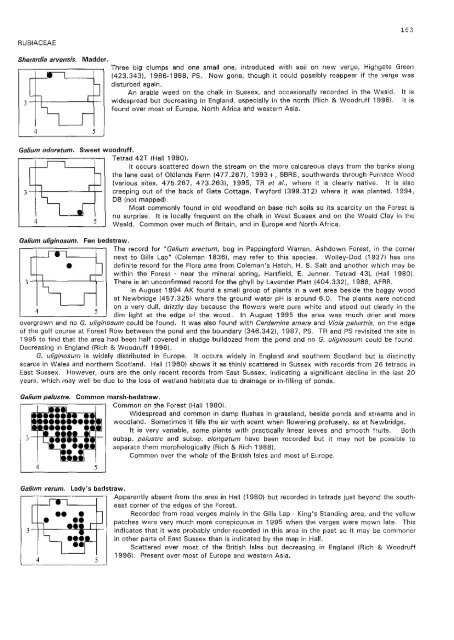Flora of Ashdown Forest - Botanical Society of the British Isles
Flora of Ashdown Forest - Botanical Society of the British Isles
Flora of Ashdown Forest - Botanical Society of the British Isles
Create successful ePaper yourself
Turn your PDF publications into a flip-book with our unique Google optimized e-Paper software.
163RUBIACEAESherardia arvensis. Madder.3 -++--------'-+-Three big clumps and one small one, introduced with soil on new verge, Highgate Green(423.3431, 1986-1988, PS. Now gone, though it could possibly reappear if <strong>the</strong> verge wasdisturbed again.An arable weed on <strong>the</strong> chalk in Sussex, and occasionally recorded in <strong>the</strong> Weald. It iswidespread but decreasing in England, especially in <strong>the</strong> north (Rich & Woodruff 1996). It isfound over most <strong>of</strong> Europe, North Africa and western Asia.4 5Galium odoratum. Sweet woodruff.Tetrad 42T (Hall 1980(.It occurs scattered down <strong>the</strong> stream on <strong>the</strong> more calcareous clays from <strong>the</strong> banks along<strong>the</strong> lane east <strong>of</strong> Old lands Farm (477.2671, 1993+, SBRS, southwards through Furnace Wood3 -++----Lt-(various sites, 475.267, 473.2631, 1995, TR et al., where it is clearly native. It is alsocreeping out <strong>of</strong> <strong>the</strong> back <strong>of</strong> Gate Cottage, Twyford (399.3121 where it was planted, 1994,4 5DB (not mappedl.Most commonly found in old woodland on base rich soils so its scarcity on <strong>the</strong> <strong>Forest</strong> isno surprise. It is locally frequent on <strong>the</strong> chalk in West Sussex and on <strong>the</strong> Weald Clay in <strong>the</strong>Weald. Common over much <strong>of</strong> Britain, and in Europe and North Africa.Galium uliginosum. Fen bed straw .The record for "Galium erectum, bog in Pappingford Warren, <strong>Ashdown</strong> <strong>Forest</strong>, in <strong>the</strong> cornernext to Gills Lap" (Coleman 1836(, may refer to this species. Wolley-Dod (19371 has onedefinite record for <strong>the</strong> <strong>Flora</strong> area from Coleman's Hatch, H. S. Salt and ano<strong>the</strong>r which may bewithin <strong>the</strong> <strong>Forest</strong> - near <strong>the</strong> mineral spring, Hartfield, E. Jenner. Tetrad 43L (Hall 19801.3 -+-+-___--L\--There is an unconfirmed record for <strong>the</strong> ghyll by Lavender Plat! (404.332(, 1988, AFRR.In August 1994 AK found a small group <strong>of</strong> plants in a wet area beside <strong>the</strong> boggy woodat Newbridge (457.325) where <strong>the</strong> ground water pH is around 6.0. The plants were noticedon a very dull, drizzly day because <strong>the</strong> flowers were pure white and stood out clearly in <strong>the</strong>4 5dim light at <strong>the</strong> edge <strong>of</strong> <strong>the</strong> wood. In August 1995 <strong>the</strong> area was much drier and moreovergrown and no G. uliginosum could be found. It was also found with Cardamine amara and Viola palustris, on <strong>the</strong> edge<strong>of</strong> <strong>the</strong> golf course at <strong>Forest</strong> Row between <strong>the</strong> pond and <strong>the</strong> boundary (346.3421, 1987, PS. TR and PS revisited <strong>the</strong> site in1995 to find that <strong>the</strong> area had been half covered in sludge bulldozed from <strong>the</strong> pond and no G. uliginosum could be found.Decreasing in England (Rich & Woodruff 19961.G. uliginosum is widely distributed in Europe. It occurs widely in England and sou<strong>the</strong>rn Scotland but is distinctlyscarce in Wales and nor<strong>the</strong>rn Scotland. Hall (1980) shoWs it as thinly scattered in Sussex with records from 26 tetrads inEast Sussex. However, ours are <strong>the</strong> only recent records from East Sussex, indicating a significant decline in <strong>the</strong> last 20years, which may well be due to <strong>the</strong> loss <strong>of</strong> wetland habitats due to drainage or in-filling <strong>of</strong> ponds.Galium palustre. Common marsh-bedstraw.Common on <strong>the</strong> <strong>Forest</strong> (Hall 19801.Widespread and common in damp flushes in grassland, beside ponds and streams and inwoodland. Sometimes it fills <strong>the</strong> air with scent when flowering pr<strong>of</strong>usely, as at Newbridge.It is very variable, some plants with practically linear leaves and smooth fruits. Bothsubsp. palustre and subsp. elongatum have been recorded but it may not be possible toseparate <strong>the</strong>m morphologically (Rich & Rich 19881.Common over <strong>the</strong> whole <strong>of</strong> <strong>the</strong> <strong>British</strong> <strong>Isles</strong> and most <strong>of</strong> Europe.Galium verum. Lady' 5 bedstraw.Apparently absent from <strong>the</strong> are_a in Hall (1980) but recorded in tetrads just beyond <strong>the</strong> sou<strong>the</strong>astcorner <strong>of</strong> <strong>the</strong> edges <strong>of</strong> <strong>the</strong> <strong>Forest</strong>.Recorded from road verges mainly in <strong>the</strong> Gills Lap - King's Standing area, and <strong>the</strong> yellowpatches were very much more conspicuous in 1995 when <strong>the</strong> verges were mown late. This3 --++_--""""Jf-1-+- indicates that it was probably under-recorded in this area in <strong>the</strong> past so it may be commoner4 5in o<strong>the</strong>r parts <strong>of</strong> East Sussex than is indicated by <strong>the</strong> map in Hall.Scattered over most <strong>of</strong> <strong>the</strong> <strong>British</strong> <strong>Isles</strong> but decreasing in England (Rich & Woodruff1996). Present over most <strong>of</strong> Europe and western Asia.
















